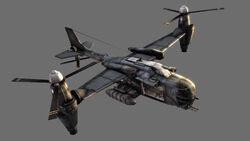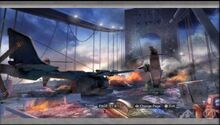
The P-1117 Kingfisher is a VTOL aircraft used by the British Army.
Overview
As the United States Armed Forces finally resolved the issues plaguing the UH-17 Atlas in 1937, a successor aircraft, the U/AV-17 Hawk was developed. With the revolutionary nature of the aircraft proving its worth, many European nations scrambled to create their own VTOL variant. Amongst these countries was the United Kingdom, whose outdated Air Force required major modernization in the face of Russian hostility. However, the country faced major setbacks when British aircraft designers failed to present acceptable aircrafts to the British Army.
Facing major consequences of being left behind, the United Kingdom negotiated with the Roosevelt Administration to utilize several previously discarded iterations as its template for their future VTOL. Eventually settling upon an older iteration of the Hawk, the United Kingdom formally adopted the P-117 Kingfisher as its VTOL variant and began mass-producing it, with several squadrons available by the start of the Chimeran War. Additionally, many Western European countries including France and Germany decided to purchase several squadrons of Kingfishers, however, the outbreak of the war meant that the delivery of the aircraft never made it to the countries.
Similarly to the Hawk, the Kingfisher was equipped with the ability to carry tanks to the battlefield and, after deploying troops, can either provide tactical support from its .30 caliber door guns or its .50 caliber nose-mounted guns. Unlike its American counterpart however, the Kingfisher's bubble canopy meant that pilots were more exposed to enemy fire, as a result, losses were high amongst VTOL pilots during the opening phase of the Chimeran War.
History
Prior to the outbreak of the Chimeran War, members of the British Intelligence Corps discovered unusual radio messages spilling out from Russia, recon teams from other European nations also discovered the sudden disappearances of entire towns bordering Russia. Assuming this was the result of a biological weapon test, the British mobilized its forces out of fear of a Russian assault on mainland Europe. Several squadrons were sent as part of the British Expeditionary Force to reinforce French and German forces.
When the Chimera breached the Red Curtain in 1949, many European countries were caught off-guard by the sudden appearance of the creatures. This badly demoralized human military forces as they fled en-masse, having only offered token resistance to the Chimera. Capturing and converting vast swaths of humans, the Chimera were further augmented as they launched repeated attacks against human forces. Overburdened by the sudden humanitarian crisis, the German government collapsed. German forces initiated a futile scorched earth policy, in the hopes of denying resources to the Chimera. Undeterred, the British deployed their squadrons, launching several attacks on the destroyed Red Curtain, suffering severe losses. Amongst these pilots participating in the offensive were Eric Hudson and Johnny Grayson.
With refugees fleeing to France, Italy and Spain - the last few standing countries still actively resisting the Chimeran onslaught - the British rallied the remaining elements of the UED at Genoa, where they formed several defensive lines.[1] However, the Chimera instead launched countless waves of Spire missiles that infected and wiped out the entire defensive lines. The few surviving Italian soldiers opted to commit suicide rather than get converted by the Chimera.
By early March 1950, France was left as the last country on the continent still resisting the Chimera, however, with most of its military decimated or converted, most fighting was left to British forces. However, as the country's defeat looked increasingly likely, the British decided to quietly pull out and divert their resources to Avalon One in Australia. Their remaining allies in the UED soon discovered this and retaliated by murdering British air crews, forcibly seizing the remaining VTOLs still in Europe and with no one to report the theft, the British were told that they were destroyed.
On 7 March, France collapsed, and the British prepared for the impending Chimeran invasion. With most of their VTOLs destroyed or stolen on the European mainland, the British were forced to spread their remaining squadrons across the country. The few VTOL pilots that had survived the European front were ordered to hastily train new pilots as the Chimera began burrowing under the English Channel. As Chimeran forces launched Dropships to harass British forces, Kingfishers were mobilized to retaliate, however, many were shot down in the ensuing dogfights as they prove little match for their Chimeran counterparts.
Sustaining severe losses, the British Intelligence Corps - now by de-facto the army's only remaining command unit - ordered the suspension of further Kingfisher deployments and instead relegated them to the role of aerial recon and combat coordination. Shore Batteries were instead set up to serve as replacements, however, they proved ineffective as Chimeran dropships continued their harassment of British forces inland. By August 1950, as the Chimera launched a full-scale invasion of Britain, the Intelligence Corps determined that the Armed Forces were too few in numbers to actively combat the Chimera, and ordered a retreat, with most of the army abandoning major cities and retreating to scattered military bases and outposts.
Launching a guerilla war, the few remaining Kingfisher's were initially actively used to deploy troops to the front, however, as the Chimera began introducing anti-air mechanical units including Stalkers and Goliaths, the Kingfishers were once again withdrawn and redeployed as recon and coordination units.
Resistance: Fall of Man
As the war dragged further, the Chimera steadily began winning the war of attrition. Increasingly desperate, elements of the British Intelligence Corps, with the approval of the British government-in-exile in Australia, negotiated directly with the United States. Having captured an Angel through unknown means, the British offered it to the Americans, who agreed to exchange it for further reinforcements and military supplies. Owing to its limited Chimeran presence, the Intelligence Corps selected York as the landing site. However, the British failed to realize that Cloven forces discovered the operation and lured Chimeran forces to the area weeks before the military exchange began.
Agreeing to meet in July 1951 in York, a ground convoy led by Captain Rachel Parker, departed Northern Command, carrying the Angel as a squadron of Kingfishers were deployed to serve as reinforcements. However, en-route to York, the convoy was ambushed in Manchester, and nearby Stalker units quickly shot down the VTOLs. As the Chimera overran the convoy, the remaining survivors were forced to surrender, where they were transported Grimsby for conversion. As a result of the ambush, the British were unable to forewarn the Americans of the Chimera, having been plagued with censorship by the Grace Administration.
Prior to the surrender of the convoy, Captain Parker had been able to notify the Intelligence Corps of their situation. Alerting Captain Mitchell who had been patrolling Manchester, he scrambled most of his men to recover the convoy, however with the Chimera entrenched and Stalker units nearby, further reinforcements were unable to deploy into the area as Mitchell fought a losing battle for most of the morning as more forces arrived to reinforce. Sometime during that period, the Intelligence Corps received a mayday transmission from Captain Parker, who had been presumed deceased following her capture at Grimsby. Well aware of the dangers of flying into Chimeran territory, the Corps nevertheless sent a Kingfisher to Grimsby, with orders to recover the Captain and Sgt. Nathan Hale - the sole survivor of the failed Operation Deliverance.
Recovering the duo, the Kingfisher departed to Manchester, where British reinforcements awaited their arrival in the outskirts of the city. Having intended to take Hale back to Northern Command for debriefing over his apparent immunity, Hale abruptly volunteered to join the Manchester operation before Parker could say otherwise. With little choice, Parker deployed further Kingfisher patrols to supervise the reinforcements with explicit orders to avoid flying too close into the city. Shortly after Hale rendezvoused with Mitchell's forces, the British forces launched a counter-attack, eliminating the entrenched Chimeran forces. As Chimeran reinforcements were eliminated, the Stalker which had been harassing Kingfisher patrols was deployed, however with the efforts of Hale, the Stalker was destroyed and Parker arrived with reinforcements and medical aid.
Intel
| “ | The British P-1117 Kingfisher is derived from an early iteration of the American U/AV-17. The Kingfisher is exceedingly able at inserting soldiers into combat situations. Unfortunately, the Chimera have responded to this ability with the Stalker AA platform. At present, all remaining Kingfishers are in the service of British Intelligence. They have been largely relegated to a role of aerial reconnaissance and combat coordination. | ” |
Resistance: Retribution
The P-1117 Kingfisher first appears during Operation Overstrike when the British launched a massive attack against the Chimera to liberate all of Western Europe. They also make appearances in other levels of the campaign, such as in the Maquis Fortress were they are used to evacuate refugees. These VTOLs can also be found destroyed throughout the game.
Resistance: Burning Skies

Concept art.
The P-1117 Kingfisher appears in Resistance: Burning Skies, being used by the U.S. Army. This is probably a mistake since the U.S. Army never used Kingfisher VTOLs and these VTOLs were only used and manufactured by the British.










